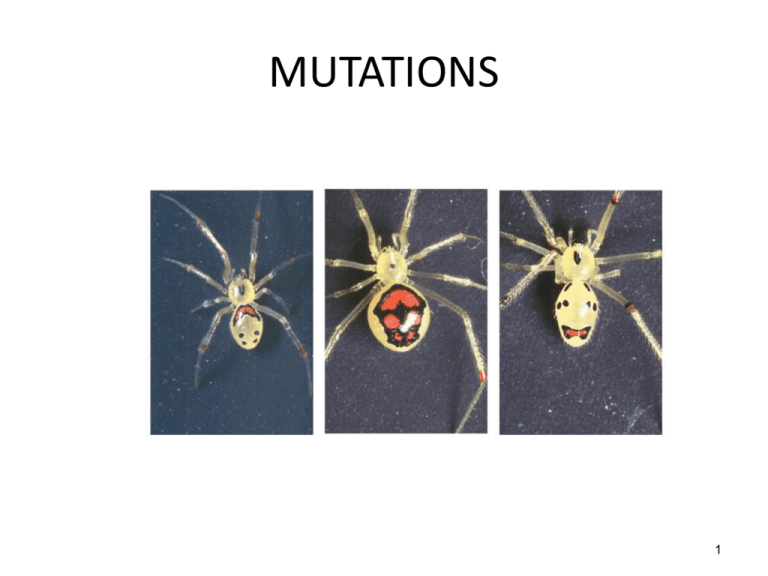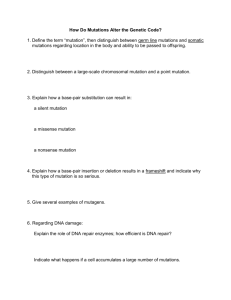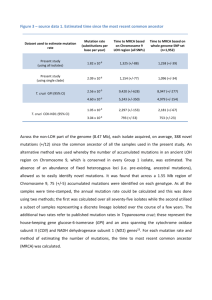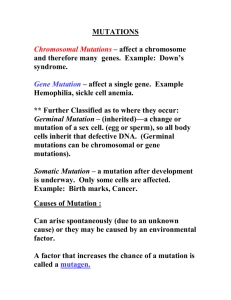Mutations - materi-kuliah
advertisement

MUTATIONS 1 What Are Mutations? • Changes in the nucleotide sequence of DNA • May occur in somatic cells (aren’t passed to offspring) • May occur in gametes (eggs & sperm) and be passed to offspring Are Mutations Helpful or Harmful? • Some type of skin cancers and leukemia result from somatic mutations • Some mutations may improve an organism’s survival (beneficial) Types of Mutations – Chromosome mutations • Changes in chromosome structure – Genome mutations • Changes in chromosome number – Single-gene mutations • Relatively small changes in DNA structure • Occur within a particular gene Chromosome Mutations • May Involve: – Changing the structure of a chromosome – The loss or gain of part of a chromosome Chromosome Mutations • Five types exist: –Deletion –Inversion –Translocation –Nondisjunction –Duplication Deletion • Due to breakage • A piece of a chromosome is lost Inversion • Chromosome segment breaks off • Segment flips around backwards • Segment reattaches Duplication • Occurs when a gene sequence is repeated Translocation • Involves two chromosomes that aren’t homologous • Part of one chromosome is transferred to another chromosomes Nondisjunction • Failure of chromosomes to separate during meiosis • Causes gamete to have too many or too few chromosomes • Disorders: – Down Syndrome – t(hree 21st chromosomes – Turner Syndrome – single X chromosome – Klinefelter’s Syndrome – XXY chromosomes Chromosome Mutation Animation Gene Mutations • Change in the nucleotide sequence of a gene • May only involve a single nucleotide • May be due to copying errors, chemicals, viruses, etc. Types of Gene Mutations • Include: –Point Mutations –Substitutions –Insertions –Deletions –Frameshift Point Mutation • Change of a single nucleotide • Includes the deletion, insertion, or substitution of ONE nucleotide in a gene Point Mutation • Sickle Cell disease is the result of one nucleotide substitution (GAA GTA ) • Valine is replaced with Glutamic Acid • Occurs in the hemoglobin gene Base Pair Substitutions : Silent Missense – new protein (Amino Acid Substitutions) Nonsense – stop codon 1. Silent mutation 5’ ATG GGA GCT CTA TTA ACC TAA 3’ met gly ala leu leu thr stop Silent mutation 5’ ATG GGA GCT CTA TTG ACC TAA 3’ met gly ala leu leu thr stop 2. Missense mutation 5’ ATG GGA GCT CTA TTA ACC TAA 3’ met gly ala leu leu thr stop Missense mutation 5’ ATG GGA GCT CTA TTT ACC TAA 3’ met gly ala leu phe thr stop 3. Nonsense mutation 5’ ATG GGA GCT CTA TTA ACC TAA 3’ met gly ala leu leu thr stop Nonsense mutation 5’ ATG GGA GCT CTA TGA ACC TAA 3’ met gly ala leu stop Frameshift Mutation • Inserting or deleting one or more nucleotides • Changes the “reading frame” like changing a sentence • Proteins built incorrectly Frameshift Mutation • Original: –The fat cat ate the wee rat. • Frame Shift (“a” deleted): – The fat cta tet hew eer at. Amino Acid Sequence Changed Gene Mutation Animation Normal Male 2n = 46 Normal Female 2n = 46 Male, Trisomy 21 (Down’s) 2n = 47 Female Down’s Syndrome 2n = 47 29 Klinefelter’s Syndrome 2n = 47 Turner’s Syndrome 2n = 45 31 CAUSES OF MUTATIONS • Chemical agents and physical agents MECHANISM of MUTAGENs • Deamination of DNA structure – Nitrous acid (HNO2) replaces amino groups of base with keto groups • -NH2 =O • Can change cytosine to uracil – Pairs with A, not G • Can change adenine to hypoxanthine – Pairs with C, not T 33 MECHANISM of MUTAGENs • Alkylation of DNA structure – Alkylating agents covalently attach methyl or ethyl groups to bases • e.g., Nitrogen mustards, ethyl methanesulfonate (EMS) – Appropriate base pairing is disrupted Effect of EMS MECHANISM of MUTAGENs • Interfere with the DNA replication process – e.g., Acridine dyes such as proflavin • Flat, planar structures interchelate into the double helix – Sandwich between adjacent base pairs • Helical structure is distorted • Single-nucleotide additions and deletions can result MECHANISM of MUTAGENs • Base analog – Some mutagens are base analogs • e.g., 2-aminopurine • e.g., 5-bromouracil (5BU) • Become incorporated into daughter strands during DNA replication Effect of BU MECHANISM of MUTAGENs • Effect of Radiation – Ionizing radiation such as X rays and gamma rays – Short wavelength and high energy – Can penetrate deeply into biological materials – Creates “free radicals” » Chemically reactive molecules – Free radicals alter DNA structure in a variety of ways » Deletions, single nicks, cross-linking, chromosomal breaks MECHANISM of MUTAGENs – Nonionizing radiation such as UV light – Contains less energy – Penetrates only the surface of material such as the skin – Causes the formation of thymine dimers – May be repaired through one of numerous repair systems – May cause a mutation when that DNA strand is replicated DETERMINING OF MUTAGENS • Ames test is commonly used • Developed by Bruce Ames – Uses his- strains of Salmonella typhimurium • Mutation is due to a point mutation rendering an enzyme inactive – Reversions can restore his+ phenotype • Ames test monitors rate of reversion mutations • Ames test – Suspected mutagen is mixed with rat liver extract and his- Salmonella typhimurium • Rat liver extract provides cellular enzymes that may be required to activate a mutagen – Bacteria are plated on minimal media • his+ revertants can be detected • Mutation frequency calculated – Compared to control









